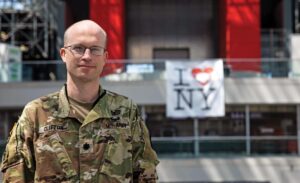Alumni Profile: Lt. Col. G. Travis Clifton, MD’06

Clifton serves key role during early pandemic in NYC
During the first surge of the COVID-19 pandemic in April 2020, Lt. Col. G. Travis Clifton, MD’06, reported for an assignment in New York City unlike any other deployment he’s completed during his 14-year Army career.
Clifton joined more than 1,000 military and civilian medical providers and support staff at the massive Jacob J. Javits Convention Center in the heart of Manhattan to quickly assemble and operate a temporary federal medical station (FMS).
“A lot of New York City did not need help – they had things fairly under control, but certain pockets, like west Queens and Elmhurst in particular, were definitely overwhelmed,” said Clifton, who is chief of General Surgery at Brooke Army Medical Center (BAMC) in Fort Sam Houston, Texas. “It was certainly an experience. I’ve been to New York plenty of times, but it was kind of surreal to be there at that time. It was like a zombie movie. No one was on the street, and it was just weird.”
Overseen by the New York State Department of Health, the Javits Center initiative was supported by federal, state and local government organizations as well as private entities. In roughly a month’s time, more than 1,000 patients would be treated there, with a peak of 453 patients in mid-April. The facility operated in coordination with the USNS Comfort, a Navy hospital ship docked in New York Harbor that treated 182 COVID-19 patients.
The Javits Center FMS was initially intended to serve as a non-COVID-19 care facility, relieving breaking-point pressure on local hospitals as they were crowded with COVID-19 patients, but after a few days of waiting for patient transfers to fill mostly empty beds, those running the FMS realized they needed a new plan.
“After we set it up there was a criticism of, ‘If all of these hospitals are overwhelmed, why isn’t the Javits Center full?’” Clifton said. “It became a throughput issue. We could only get so many patients in at one time, and the transfer process that was originally set up was a bit cumbersome. As we were rolling this out, I became involved in figuring out a way to speed this up. We decided it would make more sense to send our people out to the hospitals. There we could better see what their needs were. We could also assess a lot of patients at once and arrange for their transfer all at one time.”
Clifton and a few other on-site physicians took on the role of liaison officers and began visiting some of the hardest hit New York City hospitals. Clifton called on 10 different sites, including Elmhurst Hospital Center, a public medical facility that was overwhelmed by patients ill with the coronavirus.
“In a lot of ways, the Javits Center was similar to a deployment, in that you go to a new situation and have to provide medical care outside of your normal comfort zone, and sometimes without all of the resources you’d like,” he said. “That part I was used to, but normally you’re caring for soldiers. Caring for people who were older and scared – who reminded you of family members – that was different and tough to see.”
